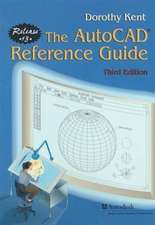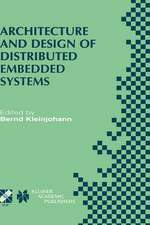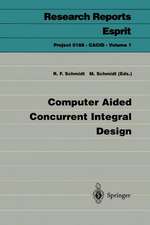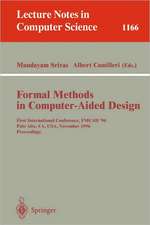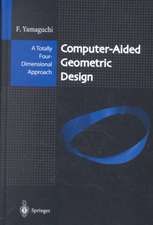Multi-Level Simulation for VLSI Design: The Springer International Series in Engineering and Computer Science, cartea 18
Autor D.D. Hill, D.R. Coelhoen Limba Engleză Paperback – 26 sep 2011
| Toate formatele și edițiile | Preț | Express |
|---|---|---|
| Paperback (1) | 642.19 lei 6-8 săpt. | |
| Springer Us – 26 sep 2011 | 642.19 lei 6-8 săpt. | |
| Hardback (1) | 648.44 lei 6-8 săpt. | |
| Springer Us – 31 oct 1986 | 648.44 lei 6-8 săpt. |
Din seria The Springer International Series in Engineering and Computer Science
- 24%
 Preț: 1041.98 lei
Preț: 1041.98 lei - 20%
 Preț: 643.50 lei
Preț: 643.50 lei - 18%
 Preț: 1225.62 lei
Preț: 1225.62 lei - 18%
 Preț: 965.02 lei
Preț: 965.02 lei - 20%
 Preț: 646.12 lei
Preț: 646.12 lei - 18%
 Preț: 948.79 lei
Preț: 948.79 lei - 20%
 Preț: 646.62 lei
Preț: 646.62 lei - 15%
 Preț: 637.46 lei
Preț: 637.46 lei - 20%
 Preț: 643.83 lei
Preț: 643.83 lei - 18%
 Preț: 949.23 lei
Preț: 949.23 lei - 20%
 Preț: 644.48 lei
Preț: 644.48 lei - 20%
 Preț: 994.92 lei
Preț: 994.92 lei - 20%
 Preț: 645.97 lei
Preț: 645.97 lei - 18%
 Preț: 946.87 lei
Preț: 946.87 lei - 20%
 Preț: 995.57 lei
Preț: 995.57 lei - 18%
 Preț: 956.99 lei
Preț: 956.99 lei - 20%
 Preț: 644.98 lei
Preț: 644.98 lei - 15%
 Preț: 649.54 lei
Preț: 649.54 lei - 18%
 Preț: 950.21 lei
Preț: 950.21 lei - 18%
 Preț: 1221.38 lei
Preț: 1221.38 lei - 18%
 Preț: 957.62 lei
Preț: 957.62 lei - 15%
 Preț: 643.99 lei
Preț: 643.99 lei - 18%
 Preț: 948.47 lei
Preț: 948.47 lei - 18%
 Preț: 947.35 lei
Preț: 947.35 lei - 20%
 Preț: 1284.65 lei
Preț: 1284.65 lei - 20%
 Preț: 1628.31 lei
Preț: 1628.31 lei - 20%
 Preț: 1285.78 lei
Preț: 1285.78 lei
Preț: 642.19 lei
Preț vechi: 802.74 lei
-20% Nou
Puncte Express: 963
Preț estimativ în valută:
122.89€ • 131.40$ • 102.46£
122.89€ • 131.40$ • 102.46£
Carte tipărită la comandă
Livrare economică 18 aprilie-02 mai
Preluare comenzi: 021 569.72.76
Specificații
ISBN-13: 9781461294016
ISBN-10: 1461294010
Pagini: 228
Ilustrații: XVI, 206 p.
Dimensiuni: 155 x 235 x 12 mm
Greutate: 0.33 kg
Ediția:1987
Editura: Springer Us
Colecția Springer
Seria The Springer International Series in Engineering and Computer Science
Locul publicării:New York, NY, United States
ISBN-10: 1461294010
Pagini: 228
Ilustrații: XVI, 206 p.
Dimensiuni: 155 x 235 x 12 mm
Greutate: 0.33 kg
Ediția:1987
Editura: Springer Us
Colecția Springer
Seria The Springer International Series in Engineering and Computer Science
Locul publicării:New York, NY, United States
Public țintă
ResearchCuprins
1. Introduction and Background.- 1.1. CAD, Specification and Simulation.- 1.2. Categories of Simulation.- 1.3. Performance-Analysis.- 1.4. Register-Level Simulation.- 1.5. Functional-Level Simulation.- 1.6. Gate-Level Simulation.- 1.7. Analog Simulation.- 1.8. Problems with the Existing Approach.- 1.9. Multi-Level Simulation.- 1.10. Genesis of ADLIB.- 1.11. Outline of This Book.- 2. Principles of Multi-Level Simulation.- 2.1. Structure and Behavior.- 2.2. Two Concepts of “Level”.- 2.3. Design Methodologies.- 2.4. Top-Down Methodology Enhanced with Simulation.- 2.5. Example: Data Acquisition System.- 2.6. Refinement of Design.- 2.7. Stimulating A Component.- 2.8. Importance of Nets.- 2.9. Summary.- 3. The ADLIB Language.- 3.1. Purpose of ADLIB.- 3.2. Pascal Control Constructs.- 3.3. Additional ADLIB Constructs.- 3.4. Designing an ADLIB Program.- 3.5. Types, Net Types and Type Checking.- 3.6. Type Checking of Nets.- 3.7. Data Types Available in ADLIB.- 3.8. Another Example: The Rs232 Interface.- 3.9. Contour Models.- 3.10. Packages and Modules.- 3.11. Global Identifiers.- 3.12. Net Types.- 3.13. Clocks.- 3.14. Subroutines.- 3.15. Component Type Definitions.- 3.16. The Heading of a Component Type Definition.- 3.17. Port Declarations in a Component Type Definition.- 3.18. Internal Signals.- 3.19. Standard Pascal Declarations.- 3.20. Subprocesses.- 3.21. The Main Body of a Component Type Definition.- 3.22. Static Structure of an ADLIB Program.- 3.23. Summary—How Languages are Defined.- 4. Examples of Designing with ADLIB.- 4.1. A Gate-Level Example.- 4.2. A High-Level Example.- 4.3. Modeling Software.- 4.4. Protocol Example Summary: Using ADLIB for Algorithm Debugging.- 4.5. Model and Algorithm Debugging.- 4.6. An Hierarchical Example.- 4.7. Summary—Multi-LevelSimulation.- 5. Advanced Principles.- 5.1. Using Model Main Bodies.- 5.2. Driver Models.- 5.3. Wired-Gate and Register Models.- 5.4. Wired-Gate Insertion.- 5.5. States and Memories.- 5.6. Synchronous and Asynchronous Processing.- 5.7. Use of Concurrent Processes.- 5.8. Pointers in Net Values.- 5.9. Model Initialization.- 5.10. Checking Timing Constraints.- 5.11. Timing Verification Algorithm.- 5.12. Timing Assertion Input.- 5.13. Performance Comparison.- 5.14. Fault Simulation.- 5.15. Symbolic Simulation.- 6. Implementation.- 6.1. Why Study an Implementation?.- 6.2. Sequence of System Programs.- 6.3. Preprocessing ADLIB into Pascal.- 6.4. Converting Component Types into Procedures.- 6.5. Generating Code to Support Net Types.- 6.6. Samples of ADLIB Preprocessor Transformations.- 6.7. Discussion: Global Variables, Scoping and Information Hiding.- 6.8. Simulation.- 6.9. Basic Data Structures.- 6.10. Accessing and Updating Nets.- 6.11. Nets Stimulating Components.- 6.12. Event Scheduling.- 6.13. Before Time = Zero.- 6.14. The Basic Event Cycle and its Efficiency.- 6.15. Interactive Support.- 6.16. Alternative Structures.- 6.17. Summary.- 7. Conclusion.- 7.1. Summary: The Essence of ADLIB.- 7.2. Lessons Learned from the Original ADLIB.- 7.3. Trends in Hardware Description Languages.- 7.4. The VHDL Language.- 7.5. Future Work.- Appendix A. ADLIB Syntax.- A. 1. Low-Level Syntax.- A.2. Summary of Operators.- A.3. Predeclared Identifiers.- A.4. Reserved Words.- A.5. Backus-Naur Form.- A.6. Comments on Syntax.- Appendix B. Packages.- B.l. Rndpak.- Appendix C. Translator Examples.- Appendix D. Symbolic Simulation Support Routines.- Appendix E. Bibliography.- Appendix F. Index.


